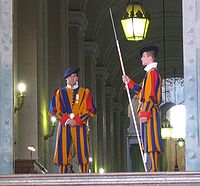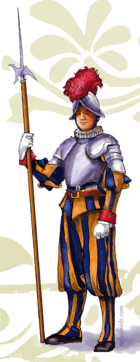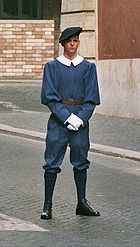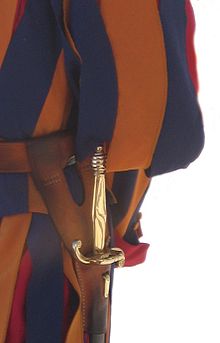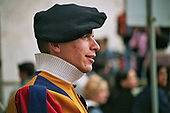- Swiss Guard
-
Swiss Guards or Schweizergarde is the name given to the Swiss soldiers who have served as bodyguards, ceremonial guards, and palace guards at foreign European courts since the late 15th century. They have had a high reputation for discipline, as well as loyalty to their employers. Apart from household and guard units, regular Swiss mercenary regiments have served as line troops in various armies; notably those of France, Spain and Naples up to the 19th century. In contemporary usage, the name Swiss Guards generally refers to the Pontifical Swiss Guard of Vatican City.
Various units of Swiss Guards existed for hundreds of years. The earliest such unit was the Swiss Hundred Guard (Cent-Garde) at the French court (1497 – 1830). This small force was complemented in 1567 by a Swiss Guards regiment. The Papal Swiss Guard now in the Vatican City State was founded in 1506 and is the only Swiss Guard that still exists. In the 18th century several other Swiss Guards existed for periods in various European courts.
The institution reflects the situation of Switzerland at the time. Unlike the present, Switzerland was a poor country whose young men often sought their fortunes abroad.
Swiss Guards in France
There were two different corps of Swiss mercenaries performing guard duties for the Kings of France: the Hundred Swiss (Cent Suisses), serving within the Palace as essentially bodyguards and ceremonial troops, and the Swiss Guards (Gardes suisses), guarding the entrances and outer perimeter. In addition the Gardes suisses served in the field as a fighting regiment in times of war.
Hundred Swiss (cent suisses)
The Hundred Swiss were created in 1480 when Louis XI retained a Swiss company for his personal guard.[1] By 1496 they comprised one hundred guardsmen plus about twenty-seven officers and sergeants. Their main role was the protection of the King within the palace as the garde du dedans du Louvre (the Louvre indoor guard), but in the earlier part of their history they accompanied the King to war. In the Battle of Pavia (1525) the Hundred Swiss of King Francis I were slain before Francis was captured by the Spanish. The Hundred Swiss shared the indoor guard with the King's Bodyguards (Garde du Corps), who were Frenchmen.
The Hundred Swiss were armed with halberds, the blade of which carried the Royal arms in gold, as well as gold-hilted swords. Their ceremonial dress as worn until 1789 comprised an elaborate 16th century Swiss costume covered with braiding and livery lace. A plainer dark blue and red uniform with bearskin headdress was worn for ordinary duties.
The cent suisses company was disbanded after Louis XVI left Versailles in October 1789. It was however refounded on 15 July 1814 with an establishment of 136 guardsmen and eight officers. The Hundred Swiss accompanied Louis XVIII into exile in Belgium the following year and returned with him to Paris following Waterloo. The unit then resumed its traditional role of palace guards at the Tuileries but in 1817 it was replaced by a new guard company drawn from the French regiments of the Royal Guard.[2]
Swiss Guards (Gardes suisses)
King Francis I of France used some 120,000 Swiss mercenaries in his wars. In 1616, King Louis XIII gave a regiment of Swiss infantry the name of Gardes suisses (Swiss Guards). The new regiment had the primary role of protecting the doors, gates and outer perimeters of the various royal palaces. This unit was officially a regiment of the line, but it was generally regarded as part of the King's Military Household.
During the 17th and 18th centuries the Swiss Guards maintained a reputation for discipline and steadiness in both peacetime service and foreign campaigning. Their officers were all Swiss and their rate of pay substantially higher than that of the regular French soldiers. Internal discipline was maintained according to Swiss codes which were significantly harsher than those of the regular French Army.
By the 16th century the Swiss Guards were brigaded with the Regiment of French Guards (Gardes françaises), with whom they shared the outer guard, and were in peace-time stationed in barracks on the outskirts of Paris. Like the eleven Swiss regiments of line infantry in French service, the Gardes suisses wore red coats. The line regiments had black, yellow or light blue facings but the Swiss Guards were distinguished by dark blue lapels and cuffs edged in white embroidery. Only the grenadier company wore bearskins while the other companies wore the standard tricorn headdress of the French infantry. The Guards were recruited from all the Swiss cantons. The nominal establishment was 1,600 men though actual numbers normally seem to have been below this.
Swiss Guards during the Revolution
The most famous episode in the history of the Swiss Guards was their defence of the Tuileries Palace in central Paris during the French Revolution. Of the nine hundred Swiss Guards defending the Palace on August 10, 1792, about six hundred were killed during the fighting or massacred after surrender. One group of sixty Swiss were taken as prisoners to the Paris City Hall before being killed by the crowd there.[3] An estimated hundred and sixty more died in prison of their wounds, or were killed during the September Massacres that followed. Apart from fewer than a hundred Swiss who escaped from the Tuileries, some hidden by sympathetic Parisians, the only survivors of the regiment were a three-hundred-strong detachment which had been sent to Normandy to escort grain convoys a few days before August 10th.[4] The Swiss officers were mostly amongst those massacred, although Major Karl Josef von Bachmann in command at the Tuileries was formally tried and guillotined in September, still wearing his red uniform coat. Two Swiss officers, the captains Henri de Salis and Joseph Zimmermann, did however survive and went on to reach senior rank under Napoleon and the Restoration.
There appears to be no truth in the charge that Louis XVI caused the defeat and destruction of the Guards by ordering them to lay down their arms when they could still have held the Tuileries. Rather, the Swiss ran low on ammunition and were overwhelmed by superior numbers when fighting broke out spontaneously after the Royal Family had been escorted from the Palace to take refuge with the National Assembly. A note has survived written by the King ordering the Swiss to retire from the Palace and return to their barracks but this was only acted on after their position had become untenable. The regimental standards had been secretly buried by the adjutant shortly before the regiment was summoned to the Tuileries on the night of 8/9 August, indicating that the likely end was foreseen. They were discovered by a gardener and ceremoniously burned by the new Republican authorities.
 The Lion Monument in Lucerne. The incised Latin may be translated, To the loyalty and courage of the Swiss.
The Lion Monument in Lucerne. The incised Latin may be translated, To the loyalty and courage of the Swiss.
The heroic but futile stand of the Swiss is commemorated by Bertel Thorvaldsen's Lion Monument in Lucerne, dedicated in 1821, which shows a dying lion collapsed upon broken symbols of the French monarchy. An inscription on the monument lists the twenty-six Swiss officers who died on 10 August and 2–3 September 1792, and records that approximately 760 Swiss Guardsmen were killed on those days.
Swiss Guards following the Restoration
The French Revolution abolished mercenary troops in its citizen army, but Napoleon I and the Restoration Monarchy both made use of Swiss troops. Four Swiss infantry regiments were employed by Napoleon, serving in both Spain and Russia. Two of the eight infantry regiments included in the Garde Royale from 1815 to 1830 were Swiss and can be regarded as successors of the old Gardes suisses. When the Tuileries was stormed again, in the July Revolution (July 29, 1830), the Swiss regiments, fearful of another massacre, were withdrawn or melted into the crowd. They were not used again. In 1831 disbanded veterans of the Swiss regiments and another foreign unit, the Hohenlohe Regiment, were recruited into the newly raised French Foreign Legion for service in Algeria.
Swiss constitutional prohibition
The Swiss constitution, as amended in 1874, forbade all military capitulations and recruitment of Swiss by foreign powers, although volunteering in foreign armies continued until prohibited outright, in 1927.
Swiss Guards in other European States
 Franz Rudolf Frisching, Colonel of the Swiss Guards in Holland, painted by Jean Preudhomme in 1785
Franz Rudolf Frisching, Colonel of the Swiss Guards in Holland, painted by Jean Preudhomme in 1785
Swiss Guard units similar to those of France were in existence at several other Royal Courts at the dates indicated below:
- From 1579 on, a Swiss Guard served the House of Savoy, rulers of Savoy and later the Kingdom of Sardinia. The Guard was dissolved in 1798.
- From 1696 to 1713, a Swiss Guard served at the court of Frederick I of Prussia.
- a Swiss Guard also existed in the Grand Duchy of Tuscany.
- a Cent-Suisse unit was in existence from 1730 until 1757 and again from 1763 to 1814 in the Kingdom of Saxony.
- a similar unit existed from 1734 until 1789 in the Kingdom of Naples. Swiss line infantry regiments continued to serve in the Neapolitan Army until the 1860s.
- From 1748 until 1796, a company of Swiss (Cent-Suisses) served as a personal guard for the Stadhouder of the Dutch Republic; besides a Dutch Guard Regiment, there was also a Swiss Guard Regiment. William I, the King of the Netherlands, incorporated 4 regiments of Swiss infantry in the new Dutch Army between 1814 to 1829, of which the 4th (Regiment Swiss nr. 32) served as Guard Infantry, until the Swiss regiments were disbanded and new official Guard Regiments of Grenadiers and Jagers were raised.
- For a brief time (1748–1767) during the reign of Empress Maria Theresa (reigned 1740–1780), approximately 250 to 450 soldiers from Switzerland were hired to guard the Hofburg, the winter palace in Vienna. They replaced previous military units that had performed that duty, and were later replaced by others. The oldest courtyard of the palace is still called the "Swiss Court" (Schweizerhof) in acknowledgement of their 20-year presence.
- In Portugal, a Swiss regiment was raised by the Count of Lippe on June 12, 1762. It comprised two battalions (commanded by Colonel Gabriel Thorman and Colonel Marcus Saussure) of 809 men each, consisting of four companies of Swiss troops plus four non-Swiss companies for a total of 1618 men. Enlistment was for a period of six years and the soldiers could not be required to serve at sea. Half the soldiers had to be Swiss while the other half could be made up of Germans and Hungarians. The Portuguese government paid the sum of 2,960,000 reis for the raising, arms and equipment of these two battalions. Colonels paid for their officers. Each soldier earned 4,537 reis per months plus a daily ration of bread. On June 22, 1763 Colonel Gabriel Thorman was sentenced to imprisonment until he returned funds and property embezzled from his regiment, while Colonel Marcus Saussure was sentenced to death for desertion. The regiment was disbanded on 17 September 1763 by a decree which also ordered the raising of a new Swiss regiment (the "Reais Estrangeiros"), which met a similar fate to its predecessor. Its eight companies comprised ninety soldiers each, plus the superior and inferior officers. It was ordered dissolved in 1765, and its commander, Colonel Luiz Henrique Graveson, condemned by a council of war to death by hanging. This sentence was commuted to a firing-squad, and the execution was carried out on November 15, 1765, in the field of Ourique, on January 2, 1766.
Pontifical Swiss Guard
Schweizergarde Active 1506 - Present Country Vatican City Branch Army Type Foot Guards Role Close Protection Size One reinforced company Garrison/HQ Vatican City Commanders Ceremonial chief Pope Benedict XVI  Group of Pontifical Swiss Guards inside St. Peter's Basilica (the suited men flanking the Clerus are Swiss Guards too)[citation needed].
Group of Pontifical Swiss Guards inside St. Peter's Basilica (the suited men flanking the Clerus are Swiss Guards too)[citation needed].
The Corps of the Pontifical Swiss Guard or Swiss Guard (German: Schweizergarde,or Das Corps der Päpstlichen Schweizergarde Italian: Guardia Svizzera Pontificia, Latin: Pontificia Cohors Helvetica, or Cohors Pedestris Helvetiorum a Sacra Custodia Pontificis) is something of an exception to the Swiss rulings of 1874 and 1927. It is a small force maintained by the Holy See and is responsible for the safety of the Pope, including the security of the Apostolic Palace. It serves as the de facto military of Vatican City.
History
The history of the Swiss Guards has its origins in the 15th century. Pope Sixtus IV (1471–1484) already made a previous alliance with the Swiss Confederation and built barracks in Via Pellegrino after foreseeing the possibility of recruiting Swiss mercenaries. The pact was renewed by Innocent VIII (1484–1492) in order to use them against the Duke of Milan. Alexander VI (1492–1503) later actually used the Swiss mercenaries during their alliance with the King of France. During the time of the Borgias, however, the Italian Wars began in which the Swiss mercenaries were a fixture in the front lines among the warring factions, sometimes for France and sometimes for the Holy See or the Holy Roman Empire. The mercenaries enlisted when they heard King Charles VIII of France was going to raise a war against Naples. Among the participants in the war against Naples was Cardinal Giuliano della Rovere, the future Pope Julius II (1503–1513), who was well acquainted with the Swiss having been Bishop of Lausanne years earlier. The expedition failed in part thanks to new alliances made by Alexander VI against the French. When Cardinal della Rovere became pope Julius II in 1503, he asked the Swiss Diet to provide him with a constant corps of 200 Swiss mercenaries. In September 1505, the first contingent of 150 soldiers started their march towards Rome, under the command of Kaspar von Silenen, and entered the city on January 22, 1506, today given as the official date of the Guard's foundation. "The Swiss see the sad situation of the Church of God, Mother of Christianity, and realize how grave and dangerous it is that any tyrant, avid for wealth, can assault with impunity, the common Mother of Christianity," declared Huldrych Zwingli, a Swiss Catholic who later became a Protestant reformer. Pope Julius II later granted them the title "Defenders of the Church's freedom".[5]
The force has varied greatly in size over the years and has even been disbanded. Its first, and most significant, hostile engagement was on May 6, 1527 when 147 of the 189 Guards, including their commander, died fighting the troops of Holy Roman Emperor Charles V in the stand of the Swiss Guard during the Sack of Rome in order to allow Clement VII to escape through the Passetto di Borgo, escorted by the other 40 guards. The last stand battlefield is located on the left side of St Peter's Basilica, close to the Campo Santo Teutonico (German Graveyard).
The Swiss Guard has served the popes since the 16th century. Ceremonially, they shared duties in the Papal household with the Palatine Guard and Noble Guard, both of which were disbanded in 1970 under Paul VI. Today the Papal Swiss Guard have taken over the ceremonial roles of the former units. At the end of 2005, there were 135 members of the Swiss Guard. This number consisted of a Commandant (bearing the rank of oberst or Colonel), a chaplain, three officers, one sergeant major (feldwebel), 30 NCOs, and 99 halberdiers, the rank equivalent to private (so called because of their traditional Halberd).
Recruitment and service
Recruits to the guards must be Catholic, single males with Swiss citizenship who have completed basic training with the Swiss military and can obtain certificates of good conduct. Recruits must have a professional degree or high school diploma and must be between 19 and 30 years of age and at least 174 cm (5 ft, 8.5 in) tall.[6] In 2009, the Swiss Guard commandant, Daniel Anrig, suggested that the Guard might someday be open to recruiting women, but he added that the admission of female recruits remained far in the future.[7]
Qualified candidates must apply to serve. If accepted, new guards are sworn on May 6 every year in the San Damaso Courtyard (Italian: Cortile di San Damaso) in the Vatican (May 6 is the anniversary of the Sack of Rome). In 2008 the ceremony took place in the presence of the head of the Swiss army. The chaplain of the guard reads aloud the oath in the language of the guard (mostly German, some French, a little Italian):
- (German version) "Ich schwöre, treu, redlich und ehrenhaft zu dienen dem regierenden Papst Benedikt XVI und seinen rechtmäßigen Nachfolgern, und mich mit ganzer Kraft für sie einzusetzen, bereit, wenn es erheischt sein sollte, selbst mein Leben für sie hinzugeben. Ich übernehme dieselbe Verpflichtung gegenüber dem Heiligen Kollegium der Kardinäle während der Sedisvakanz des Apostolischen Stuhls. Ich verspreche überdies dem Herrn Kommandanten und meinen übrigen Vorgesetzten Achtung, Treue und Gehorsam. Ich schwöre, alles das zu beobachten, was die Ehre meines Standes von mir verlangt."
- (English translation) "I vow to faithfully, honestly and honourably serve the reigning Pope Benedict XVI and his legitimate successors, and to dedicate myself to them with all my strength, ready to sacrifice, should it become necessary, even my own life for them. I likewise assume this promise toward the members of the Sacred College of Cardinals during the period of the Sede Vacante of the Apostolic See. Furthermore, I pledge to the Commandant and to my other superiors respect, fidelity, and obedience. I swear to abide by all the requirements attendant to the dignity of my rank."
When his name is called, each new guard approaches the Swiss Guard's flag, grasping the banner in his left hand. He raises his right hand with his thumb, index, and middle finger extended along three axes, a gesture that symbolizes the Holy Trinity, and speaks:
- "Ich, [Name des Rekruten], schwöre, alles das, was mir soeben vorgelesen wurde, gewissenhaft und treu zu halten, so wahr mir Gott und seine Heiligen helfen."
- "I, [name of the new guard], swear diligently and faithfully to abide by all that has just been read out to me, so grant me God and so help me his Saints."
The term of service is between 2 and 25 years.
Uniforms
The official dress uniform is of blue, red, orange and yellow with a distinctly Renaissance appearance. Commandant Jules Repond (1910–1921) created the current uniforms in 1914.[8] While both Michelangelo and a painting of the Swiss Guard bearing Pope Julius II on a litter (by Raphael) are often cited as inspiration for the Swiss Guard uniform,[8] the actual uniforms worn by those soldiers are of the style which appears by today's standards as a large skirt, a common style in uniforms during the Renaissance.
A very clear expression of the modern Swiss Guard uniform can be seen in a 1577 fresco by Jacopo Coppi of the Empress Eudoxia conversing with Pope Sixtus III. It is clearly the precursor of today's recognizable three-colored uniform with boot covers, white gloves, a high or ruff collar, and either a black beret or a black Comb morion (silver for high occasions). Sergeants wear a black top with crimson leggings, while other officers wear an all-crimson uniform.
The regular duty uniform is more functional, consisting of a simpler solid blue version of the more colorful tri-color grand gala uniform, worn with a simple brown belt, a flat white collar and a black beret.[8] For new recruits and rifle practice, a simple light blue overall with a brown belt may be worn. During cold or inclement weather, a dark blue cape is worn over the regular uniform. The original colors (blue and yellow) were issued by Pope Julius II taking his family (Della Rovere) colors. Pope Leo X added the red to reflect his family's Medici colors.
Headwear is typically a black beret for daily duties, while a black or silver morion helmet with red, white, yellow and black, and purple ostrich feather is worn for ceremonial duties, the former for guard duty or drill; the latter for high ceremonial occasions such as the annual swearing in ceremony or reception of foreign heads of state.
The tailors of the uniforms work inside the Swiss Guard barracks. The uniform weighs 8 pounds (3.6 kg), and may be the heaviest uniform in use by any standing army today. The Renaissance style makes them one of the most complicated to construct. A single uniform requires 154 pieces and takes nearly 32 hours and 3 fittings to complete.[9]
Equipment
Building on tradition, members wear a long sword (officers a rapier or straight sabre) and receive instruction in the ceremonial use of their halberd on a four-sided pole which is held on their right during marches, drill, and regular formations in their official duties around the Vatican. The halberd includes a loose metal ring just below the halberd blade, which makes a loud clink when an individual or formation comes to attention. Other weapons and regalia carried by higher ranking non-halberdiers include a command baton, a partisan, a flamberge (a wavy two-handed sword), and a breastplate with shoulder guards.
Besides their traditional arms, the Swiss Guard also has contemporary non-ceremonial small arms. The Guard also engages in yearly rifle competition and receives self-defense instruction, as well as basic instruction on defensive bodyguard tactics similar to those used in the protection of many heads of state.[10]
The Swiss Guard use the SIG Sauer P220 handgun (P75) and the SIG SG 550 assault rifle. These are the standard issue weapons of the Swiss Army. The Swiss Army have promised to provide standard issue weapons to the Swiss Guard. These weapons would be familiar to the Swiss Guard as all members have served in the Swiss Army.
Other issues
After the May 13, 1981 assassination attempt on Pope John Paul II by Mehmet Ali Ağca, a much stronger emphasis has been placed on the Swiss Guards' functional, non-ceremonial roles. This has included enhanced training in unarmed combat and small arms.
On May 4, 1998, the Swiss Guard experienced one of its greatest scandals in over 100 years when the commander of the Guard, Alois Estermann was murdered in unclear circumstances in Vatican City. According to the official Vatican version,[citation needed] Estermann and his wife, Gladys Meza Romero, were killed by the young Swiss Guard Cédric Tornay, who later committed suicide. Estermann had been named commander of the Swiss Guard the same day.
Ranks of the Pontifical Swiss Guard
Commissioned officers
- Oberst (Colonel — the commandant of the Guard)
- Oberstleutnant (Lieutenant Colonel — the vice-commandant)
- Kaplan (Chaplain — considered the same rank as a lieutenant colonel)
- Major
- Hauptmann (Captain)
Non-commissioned officers
- Feldwebel (Sergeant-major)
- Wachtmeister (Sergeant)
- Korporal (Corporal)
- Vizekorporal (Vice-corporal; closest British equivalent would be lance corporal)
Enlisted
- Hellebardier/Gardist (Halbardier/Guardsman)
Insignia
2006 anniversary - 500 years in service
In April–May 2006, to celebrate 500 years in the line of duty a group of veteran guards marched from Switzerland to Rome, a month long journey through Italy. In a public ceremony on May 6 the 33 new guards were sworn in on the steps of St. Peter's Basilica instead of the traditional venue in the San Damaso Courtyard.
Also on parade at this event were the Company of Pikemen and Musketeers of the Honourable Artillery Company of London. The Band and Corps of Drums of the HAC also provided musical support, and HAC members attended as guests.
Banner
The Pontifical Swiss Guard banner is divided by a white cross into quarters. In the right lower corner is displayed Pope Julius II's coat-of-arms, in the middle is displayed the commander's own coat-of-arms. The ruling Pope's coat-of-arms is in the left upper quarter: the other quarters display the Swiss Guard colors.
Commanders of the Pontifical Swiss Guard
- Kaspar von Silenen, Uri (1506–1517)
- Markus Röist, Zürich (1518–1524)
- Kaspar Röist, Zürich (1524–1527)
- Jost von Meggen, Luzern (1548–1559)
- Kaspar Leo von Silenen, Luzern (1559–1564)
- Jost Segesser von Brunegg, Luzern (1566–1592)
- Stephan Alexander Segesser von Brunegg, Luzern (1592–1629)
- Nikolaus Fleckenstein, Luzern (1629–1640)
- Jost Fleckenstein, Luzern (1640–1652)
- Johann Rudolf Pfyffer von Altishofen, Luzern (1652–1657)
- Ludwig Pfyffer von Altishofen, Luzern (1658–1686)
- Franz Pfyffer von Altishofen, Luzern (1686–1696)
- Johann Kaspar Mayr von Baldegg, Luzern (1696–1704)
- Johann Konrad Pfyffer von Altishofen, Luzern (1712–1727)
- Franz Ludwig Pfyffer von Altishofen, Luzern (1727–1754)
- Jost Ignaz Pfyffer von Altishofen, Luzern (1754–1782)
- Franz Alois Pfyffer von Altishofen, Luzern (1783–1798)
- Karl Leodegar Pfyffer von Altishofen, Luzern (1800–1834)
- Martin Pfyffer von Altishofen, Luzern (1835–1847)
- Franz Xaver Leopold Meyer von Schauensee, Luzern (1847–1860)
- Alfred von Sonnenberg, Luzern (1860–1878)
- Louis-Martin de Courten, Wallis (1878–1901)
- Leopold Meyer von Schauensee, Luzern (1901–1910)
- Jules Repond, Freiburg (1910–1921)
- Alois Hirschbühl, Graubünden (1921–1935)
- Georg von Sury d'Aspremont, Solothurn (1935–1942)
- Heinrich Pfyffer von Altishofen, Luzern (1942–1957)
- Robert Nünlis, Luzern (1957–1972)
- Franz Pfyffer von Altishofen, Luzern (1972–1982)
- Roland Buchs, Freiburg (1982–1997, 1998)
- Alois Estermann, Luzern (1998)
- Pius Segmüller, St. Gallen (1998–2002)
- Elmar Theodor Mäder, St. Gallen (2002–2008)
- Daniel Rudolf Anrig, St. Gallen (2008-)
Former Pontifical Guard Corps
- Noble Guard
- Palatine Guard
- Corsican Guard
- Papal Zouaves
In popular culture
- When writing Hamlet, Shakespeare assumed (perhaps relying on his sources) that the royal house of Denmark employed a Swiss Guard: In Act V, Scene v (line 98) he has King Claudius exclaim "Where are my Switzers? Let them guard the door".[11]
- George Bernard Shaw's 1894 play, Arms and the Man and Oscar Straus's operetta The Chocolate Soldier, which it inspired, involve a Swiss man volunteering for service in a (fictional) war in the Balkans, which was possible at the time it was written.
- The Pontifical Swiss Guards play a major part in Dan Brown's book Angels and Demons, which describes a fictional conspiracy to destroy the Vatican.
- The Pontifical Swiss Guards, known as Papal Guard, play a minor role in the open-world game Assassin's Creed: Brotherhood, where they are the guards of Pope Alexander VI and are commanded by the captain general of the Papal Armies, Cesare Borgia.
- In Tom Clancy's Sum of All Fears, the Swiss Guards are integral to the new plan for peace in Israel. Outfitted in urban camouflage tactical gear and equipped with modern weapons, they are the chosen solution to security on the Temple Mount. They are nicknamed 'Robosoldiers' for their appearance and demeanor (all are over 6'1" (185 cm) tall and weigh at least 180 lbs (85 kg)).
- In the two last books of the Hyperion Cantos, where the Catholic Church rules a large part of the humanity, Swiss Guards are elite forces in its military.
- Swiss guards may be hired as mercenaries in the popular 2005 real-time strategy game, Age of Empires III.
References
- ^ Rene Chartrand: "Louis XV's Army - Foreign Infantry p.3; ISBN1 85532 623 X
- ^ Liliane et Fred Funcken: "L'Uniforme et les Armes des Soldats de La Guerre en Dentelle"; ISBN 2-203-14315-0
- ^ M.J Sydenham, page 111, "The French Revolution", B.T. Batsford Ltd, 1965
- ^ Jerome Bodin, page 259, "Les Suisses au Service de la France", ISBN 2-226-03334-3
- ^ History of the Pontifical Swiss Guards Official Vatican web page, Roman Curia, Swiss Guards, retrieved August 7, 2006.
- ^ Admission requirements Official Vatican web page, Roman Curia, Swiss Guards, retrieved August 7, 2006
- ^ "Pope thanks Swiss Guard for dedicated, loyal service", Catholic News Service, 7 May 2009
- ^ a b c "The Swiss Guard - Uniforms". The Vatican. http://www.vatican.va/roman_curia/swiss_guard/swissguard/divisa_en.htm. Retrieved 2011-04-17.
- ^ National Geographic: Inside the Vatican,2001
- ^ "Vatican's honour to Swiss Guards". BBC News. May 6, 2006. http://news.bbc.co.uk/2/hi/europe/4980362.stm.
- ^ Philip Haythornthwaite, page 85 "The French Revolutionary Wars 1789-1802", ISBN 0 7137 0936 7
- Alvarez, David. The Pope's Soldiers: A Military History of the Modern Vatican. University Press of Kansas, 2011.
- Richard, Christian-Roland Marcel. La Guardia Svizzera Pontificia nel corso dei secoli. Leonardo International, 2005.
- Royal, Robert. The Pope's Army: 500 Years of the Papal Swiss Guard. Crossroads Publishing Co, 2006.
- Roland Beck-von Büren: Päpstliche Schweizergarde in German, French and Italian in the online Historical Dictionary of Switzerland. Version of 2005-08-29.
- Henry, P.: Gardes suisses in German, French and Italian in the online Historical Dictionary of Switzerland. Version of 2005-06-08.
- Bodin, J.: Les Suisses au Service de la France; Editions Albion Michael, 1988. ISBN 2-226-03334-3.
- Bertin, P.: Le Fantassin de France; Service Historique de L'Armee de Terre, 1988.
- Serrano, Antonio. Die Schweizergarde der Päpste. Verlagsanstalt >>Bayerland<<, 1992.
- National Geographic: Inside the Vatican, 2001.
External links
- Official website
- The Vatican's Official Swiss Guard site
- Contemporary account of the attack on the Tuileries and the massacre of the Swiss Guards, August 10, 1792
- Swiss Watchers, The Guardian, April 5, 2005
- Giga-Catholic Information
- Oath ceremony photo
- Five Hundred Years of Loyalty
- Insignia of Rank (officers and other ranks) Pontifical Swiss Guard at uniforminsignia.com
Categories:- Military of Vatican City
- Pontifical Swiss Guard
- Guards regiments
- Swiss society
- Mercenary units and formations
- Guards regiments of France
- Military units and formations of the Early Modern era
- Security guards
- 1506 establishments
- Law enforcement in Vatican City
Wikimedia Foundation. 2010.




